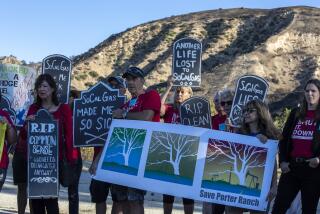Firms Tout Natural Gas Terminals
- Share via
Two energy companies seeking to build separate natural gas terminals off the Ventura County coast took their case directly to the public this week, hoping to allay safety concerns and to stress California’s need to import more natural gas to fuel its power plants.
Representatives for Houston-based Crystal Energy and Australia-based BHP Billiton told a group of about 150 Oxnard residents gathered Thursday night that the facilities would provide a much-needed alternative for importing natural gas that would eventually lead to a reduction in energy costs. California currently imports 85% to 90% of its natural gas supplies.
“Places like Arizona and Nevada are growing so fast, they are using more of it before it gets to California,” said Simon Poulter, an environmental consultant for Crystal Energy. “Our demand is very high and we don’t have enough production in the state.”
But local residents and activists expressed fears that the projects, which would be located off the Oxnard shore, could become an environmental disaster, creating risks of accidental explosions and the release of methane vapors.
“I want more information before I’m going to be able to sleep better,” said Brett Johnson of Oxnard. “I think people here are very wary of these outsiders dictating how their lives will be affected.”
On Friday, some residents and officials remained unconvinced that the fuel terminals would be safe from accidents, earthquakes or even terrorist attacks. Some also suggested that the energy companies may have chosen Oxnard because it is a largely Latino and blue-collar city that would be less likely to mount strong opposition than more affluent communities.
“I don’t see them putting these in Montecito, Santa Barbara or Malibu,” said Irma Lopez, wife of Oxnard Mayor Manuel Lopez. “If I’m going to be accused of being closed-minded on this, then so be it.”
But officials for both companies said they chose the site simply because Ventura County had existing pipelines used for these types of projects. Reliant Energy currently operates a power plant at Ormond Beach in Oxnard.
“The nature of the demographics had nothing to do with our site selection,” said Steve Meehen, BHP Billiton development manager. “Part of the site-selection process was [determining where] in California you have a pipeline system in a coastal region where it’s feasible to connect to.”
Meehen said BHP Billiton officials investigated sites in California, Mexico and other West Coast states before deciding on the Ventura County site.
“We came back to the same conclusion every time,” Meehen said. “The most viable place to work was where we selected.”
BHP Billiton wants to construct a $500-million floating terminal about 20 miles from Oxnard that would act as a receiving point for shipments of California-bound natural gas. The stored liquefied gas would be converted to vapor through a heat exchange system and transported by an undersea pipeline to a gas utility’s pipeline near Ormond Beach, officials said.
Crystal Energy proposes to convert an old oil platform 11 miles off the Oxnard shore into a similar facility. Officials believe the $125-million terminal would eventually pump out enough fuel to meet a quarter of the state’s residential energy needs.
Representatives from both companies stressed that locating the facilities offshore would greatly reduce any safety risks, which they said were minimal.
During Thursday’s meeting, which was sponsored by Ventura County Supervisor John Flynn and the Oxnard Inter-Neighborhood Council, an outspoken local attorney made a presentation in which he elaborated on the possibility of large flammable vapor clouds and compared the energy content of one standard liquid natural gas tanker to 55 atomic bombs.
“I’m not trying to be an alarmist here,” attorney Tim Riley said as audience members shook their heads and looked at black-and-white pictures of a natural gas accident in Cleveland in 1944.
But officials from the two energy companies provided a handout in which they tried to debunk many of Riley’s claims, stressing that technology and safety procedures have dramatically improved since the time of the accident he cited.
They also noted that liquid natural gas, or LNG, was already widely used in California, and that some of Riley’s disaster scenarios were simply implausible.
“Mr Riley did qualify his presentation by saying that he doesn’t know anything about natural gas and LNG, and that he’s not an expert in any of those fields,” Meehen said.
More to Read
Sign up for Essential California
The most important California stories and recommendations in your inbox every morning.
You may occasionally receive promotional content from the Los Angeles Times.













